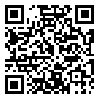Volume 15, Issue 10 (1-2016)
Modares Mechanical Engineering 2016, 15(10): 97-103 |
Back to browse issues page
Download citation:
BibTeX | RIS | EndNote | Medlars | ProCite | Reference Manager | RefWorks
Send citation to:



BibTeX | RIS | EndNote | Medlars | ProCite | Reference Manager | RefWorks
Send citation to:
Rezaee M, Fathi R. Presenting and dynamic analysis of a new type of three-ball automatic balancer. Modares Mechanical Engineering 2016; 15 (10) :97-103
URL: http://mme.modares.ac.ir/article-15-4730-en.html
URL: http://mme.modares.ac.ir/article-15-4730-en.html
1- Associate Professor - University of Tabriz
Abstract: (4531 Views)
The unbalancing is a destructive phenomenon and is a major cause of undesired vibrations in rotating machinery. One of the new methods used to reduce the imbalance is the implementing of automatic dynamic ball balancer. In previous studies the dynamic behavior of automatic ball balancer has been investigated. These studies indicate numerous advantages of automatic ball balancer. However, the traditional automatic ball balancer has two major deficiencies: First, the rotor vibration amplitude is larger than that of a rotor without an automatic ball balancer in speeds below the first critical speed and, the second deficiency is that it has a limited stable region of the perfect balancing configuration. In this paper, a new design of a three-ball automatic balancer is introduced. The governing equations of motion are derived using the Lagrange's equations, and the balanced stable region is obtained. It is shown that this type of automatic ball balancer can prevent from increasing the vibrations of the rotor at the speed range below the first critical speed. Moreover, the new type of balancer increases the balance stable region of the system. Reducing the vibration amplitude in the mentioned range causes the life time of the system to be increased. Moreover, increasing the balanced stable range makes the new design of balancer can balance the systems with a wider range of parameters.
Article Type: Research Article |
Subject:
Vibration
Received: 2015/07/7 | Accepted: 2015/08/18 | Published: 2015/08/30
Received: 2015/07/7 | Accepted: 2015/08/18 | Published: 2015/08/30
| Rights and permissions | |
 |
This work is licensed under a Creative Commons Attribution-NonCommercial 4.0 International License. |







